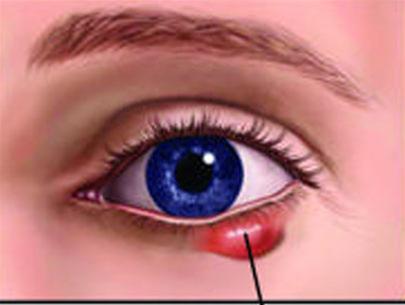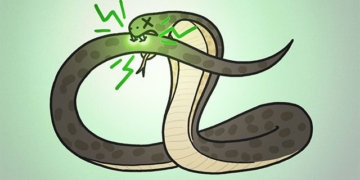Infections, styes, chalazia, and allergies are all conditions related to the eyelids. Understanding these conditions helps you keep your eyes looking beautiful. The eyelids are 0.35mm thick and experience over 10,000 muscle contractions in a day, making the skin on the eyelids particularly susceptible to various disorders.
The eyelids are very sensitive and delicate. Yet, they form the final “fortress” protecting the eyes. It is essential to pay attention to the eyelids to prevent infections that can affect the eyes.
What is Blepharitis?
 |
Chalazion (Image: TTO) |
It is an inflammation of the eyelid margins that can be associated with conjunctivitis. This condition often recurs.
Symptoms: Blepharitis is characterized by eyelid swelling and redness of the eyelid margins. Sometimes, crusts form at the eyelash follicles, causing discomfort. In the morning, eyelids may stick together, and one may experience itching or the sensation of a foreign body in the eye.
Treatment: An antibiotic gel combined with eye drops is usually sufficient to heal blepharitis. If the eyelids are swollen, topical corticosteroid treatment may be necessary.
Precaution: Individuals with rosacea or seborrheic dermatitis, oily skin, or dry eyes are at higher risk of recurrence.
What to Avoid: Wearing contact lenses during treatment.
What to Do: Maintaining absolute hygiene is the key to preventing recurrence. Apply warm compresses to the crusts on the lower eyelid multiple times a day for 10 minutes each time. Then, use a cotton swab dipped in baby shampoo to clean, followed by rinsing with saline solution.
Important to Know: Poor hygiene can lead to complications like styes or chalazia.
Home Remedies: At night, using a humidifier is very effective for dry eyes. During the day, close your eyes and rotate your eyeballs in a circular motion multiple times a day. Additionally, use eye drops for dry eyes.
What is a Stye?
A small infected bump on the eyelid margin is indicative of a staphylococcal infection, presenting as a white pus-filled spot resembling a pea. It typically forms on the outer surface of the eyelid and is often concentrated under the eyelid.
Symptoms: An abscess that causes a feeling of tightness and pain. It appears quickly and progresses with openings that allow pus to escape, which is very painful and often recurs.
Treatment: A stye usually drains on its own. To promote healing, apply antibiotic ointment three times a day.
What to Do: Eyelid hygiene is essential to prevent recurrence. Use a cotton swab with mineral water to clean.
What to Avoid: Rubbing your eyes with your hands. Puncturing the stye with a needle due to the risk of infection.
What is a Chalazion?
A chalazion is a hard, well-defined lump that forms on the outer surface of the eyelid. The appearance of the cyst is associated with blockage of the Meibomian gland duct, which produces lipids to mix with tears.
Symptoms: The eyelid becomes swollen, the skin reddens, and a white substance may discharge, adhering to the eyelashes. When dry, this substance forms flakes that prevent the eyelid from opening. Chalazia are less painful than styes and progress more slowly.
Treatment: Corticosteroid therapy is often enough to cause the chalazion to disappear. If the chalazion does not resolve, a local anesthetic may be administered to incise and drain the pus. Chalazia often recur, and specialized treatment is necessary to limit chronic chalazia.
What to Do: Apply a warm compress to the chalazion to help it “ripen” faster.
Important to Know: Individuals with recurrent chalazia should undergo examinations to rule out Meibomian gland cancer.
How Does Eyelid Allergy Manifest?
The skin on the eyelids contains many sensitive cells. Even mild contact with allergens can trigger an immune response. Related products used directly on the eyelids (makeup, eyeliner, mascara), from a distance (hair dye), on the face (foundation, face cream), or on the hands (nail polish) can pose risks. Allergies can also occur due to contact with cosmetics or eyeglass frames.
Symptoms: Eczema may ooze or alternatively, be dry and red like elephant skin. Allergies can cause itching and a painful sensation.
Treatment: Immediately stop using the suspected allergen. Temporarily discontinue all cosmetics while eczema is present, then reintroduce each type of cosmetic one at a time at weekly intervals to identify the exact “culprit.”
What to Do: To reduce the feeling of tightness, apply ointments containing vitamin A or Vaseline. Choose preservative-free single-dose eye drops that do not contain allergens. Daily disposable contact lenses are recommended as these products can sometimes irritate the eyes.
What to Avoid: Rubbing the eyes, as this can exacerbate allergies.
Eye Injuries:
Symptoms: After an impact, the eyelids become swollen and discolored.
Treatment: It is advisable to see a doctor, as a hematoma can cause discomfort when opening and closing the eyelids, and the eye may be affected.
In such cases, the bruise may need to be incised to drain the hematoma, and anti-inflammatory medication may be prescribed.
What to Do: To reduce eyelid swelling, apply a cold compress or ice wrapped in cloth to the injury.
Wounds on the Eyelids
Wounds from sharp objects or animal bites should be closely monitored by a doctor. The eyelids have a rich blood supply and can bleed significantly, which can lead to serious conditions.
Treatment: If it is a superficial wound, immediate suturing is necessary. If not, an ophthalmologist will conduct comprehensive tests to identify any potential eye injuries and ensure that sutures do not interfere with the natural opening and closing of the eyelids. Dog bites can cause lacerations to the eyelids.
What to Do: Seek emergency care immediately. If there is excessive bleeding, apply a bandage to the wound while waiting for help.
Important to Know: Any superficial wound is at risk of viral infection causing tetanus. Immediate vaccination is recommended.
Be Aware of Cancer
Up to 60% of facial cancer cases occur around the eyelids. Professor Morax asserts, “This is one of the most common cancers, however, eyelid cancer has a good prognosis.”
Symptoms: The affected area may show frequent bleeding. The condition can lead to eyelash loss and eyebrow hair loss… It is typically not painful, progresses slowly, and gradually enlarges.
Treatment: An ophthalmologist will perform a biopsy to investigate the source of the tumor and surgically remove it.
Need to Know: There is no risk of confusion with a stye or chalazion. Only tumors change shape and bleed. Do not hesitate to seek medical advice if in doubt.
Dr. ĐẶNG MINH TRÍ



















































